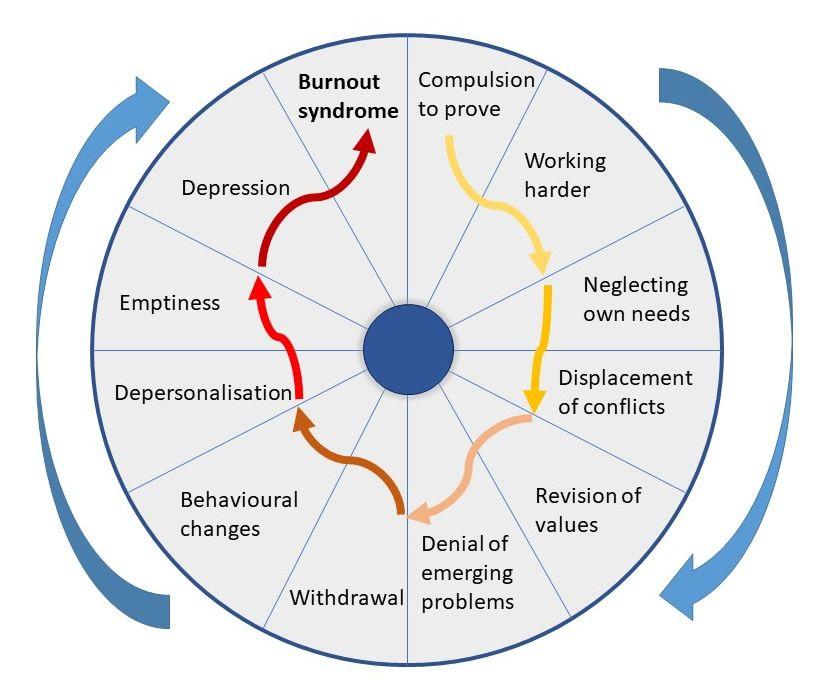Few people had heard, let alone used, the phrase the ‘Great Resignation’ before last summer. It’s the term coined for the many thousands of people who started quitting their jobs in droves from early 2021. The US Bureau of Labor Statistics had the numbers spiking at an all-time high last September of 4.4 million.
And the trend in churn isn’t showing signs of slowing anytime soon. The CIPD claimed 2 out of 5 (41%) employers reported an increase in staff turnover or difficulty retaining staff in the previous six months.
Many have speculated about causes, with some economists likening the ‘Big Quit’ to a general strike against pay and conditions. Health and safety concerns over Covid-19 undoubtedly contributed as a cause as did stagnant wages, childcare obligations and higher costs of living. But a third (33%) of UK professionals* cited ‘burnout’ as to why they were looking for a new job in 2022. [Source: CV Library 2021].
What is burnout?
In 2019, the World Health Organisation (WHO) recognised burnout as an ‘occupational phenomenon’, claiming it was characterised by three dimensions:
- feelings of energy depletion or exhaustion;
- increased mental distance from one’s job, or feelings of negativism or cynicism related to one’s job; and
- reduced professional efficacy.
While the WHO made it clear it wasn’t classified a medical condition, burnout undoubtedly impacts on health and wellbeing.
In May we are running several live webinars on topics related to stress and burnout
Interested in joining one of our webinar events, or perhaps scheduling an event for your employees? Take a look at our Events Calendar page, or contact us for further information.
A cocktail of causes
It’s rarely just one factor that causes burnout, the cocktail mix that finally impacts on someone’s physical and mental health is completely individual. Overwork could be the driver that moves someone from wellness ⇒ stress ⇒ ignored stress ⇒ burnout but there will be other contributory factors such as:
- Fears about job security/financial wellbeing
- Personal worries like health or home/relationship
- Minimal control over deadlines or workloads
- Not feeling either appreciated or valued by employers
- Challenging or difficult relationships with line managers or colleagues
Covid-19’s impact on burnout
The Coronavirus reminded everyone that people are not machines. They worried about their safety, their health, their children, home schooling, how they’d cope financially and while they were worrying about all that they were unlikely to be as productive as usual.
Technology undoubtedly proved a lifeline during the pandemic, it not only enabled people to stay connected with work but also to their friends and family. But it was a two-edged sword. As many working from home (WFH) discovered, the lines became blurred about when work started and when it ended so, for many, it became incumbent on employers to establish boundaries for homeworking employees in order that they didn’t succumb to stress or burnout.
A study revealed that 2 in 5 of those working from home were starting workdays earlier or finishing later, and over a third were skipping lunch breaks in order to demonstrate productivity to their manager. The same research revealed that nearly half (46%) of people felt less connected to their company, while 42% reported company culture as having diminished since the start of the pandemic.
It’s understandable that with so many people WFH many companies lost some of their traditional avenues of establishing and maintaining company culture and engaging employees in areas like work/life balance.
But Covid-19 really shone a light on how employees were treated, and workers voted with their feet. They stayed with those that supported them and walked from those that didn’t. Companies that failed to even acknowledge or support peoples’ worries outside of work suffered. Employees seriously questioned how their health or happiness had been considered during the pandemic.
Spotting employee burnout
Long hours – someone who is consistently working beyond their conditioned hours, or taking holiday to catch up on work (leavism) could be struggling with workload and at risk of stress and, potentially, burnout.
Reduced performance – presenteeism is when someone’s not fully engaged at work, their concentration is suffering as are their productivity levels.
Time off – absenteeism is when people start spending inexplicable time away from work under the guise of leave, sickness, appointments
Physical signs – Poor personal hygiene, frequently hungover, tired/lacking energy, tearful are just some of the visible signs that someone could be approaching burnout.
Not ‘themselves’ – someone acting out of character could be a symptom of burnout, behaviour such as risk-taking, aggression or disinterest.
Faking it – Pleasanteeism is a relatively new employee phenomena where people feel under pressure to hide feelings or stress and anxiety and put on a brave ‘pleasant’ face.
Nearly 50 years ago (1973), German-born American psychologist Herbert Freudenberger brought the concept of burnout to professional and public awareness, defining it as a state of mental and physical exhaustion caused by one’s professional life. He defined the 12 stages of burnout progression as:

The 12-stage model for the development of burnout as described by Freudenberger.
Strategies for pre-empting or tackling burnout in your business
As mentioned earlier, a third of professionals cite burnout as a reason for wanting to change jobs, so it’s becoming even more imperative that employers make serious investment in areas like health and wellbeing if they’re to retain talent. The CIPD claimed in its winter 2021/2022 Labour Market Outlook that 45% of employers with retention difficulties had been putting a greater focus on employee wellbeing with initiatives such as Employee Assistance Programmes (EAP).
In 2020/21, 822,000* workers were said to be suffering from work-related stress, depression or anxiety and that’s just the figures of those that admit to it. [*Source: HSE. Health and safety at work. Summary Statistics for Great Britain 2021.]
- Employee workloads and expectations
According to the CIPD, workloads remain the most common cause of stress at work. Keep monitoring and discussing workloads with employees, hold regular meetings with teams and individuals to discuss potential busy spikes or particularly tight deadlines. Set achievable demands that match an individuals’ skills and capabilities.
- Equipping the frontline
Management style is the second biggest cause of stress at work says the CIPD. Managers play a crucial role in the working life of employees, from creating the right environment to enable people to thrive to being an empathic first port of call when someone is struggling with their health. Providing line manager training makes your frontline managers better equipped to identify and deal with behavioural changes and signs of stress like presenteeism.
- Developing open and healthy culture
Throughout the pandemic, many businesses lost traction on employee engagement in areas like work/life balances, recognition programmes and enabling change post employee feedback. Consider training up some wellbeing champions to promote awareness of the importance of physical health and wellbeing in the workplaces, to not only support colleagues but also drive positive cultural change.
Thrive4Life has more than 30 years’ experience of delivering specialist health, safety and wellbeing guidance across multiple sectors.
For more information about our services and training courses please get in touch or call us on 020 8972 9675.










